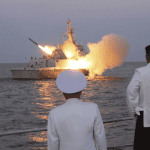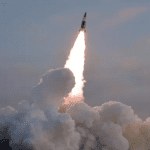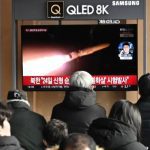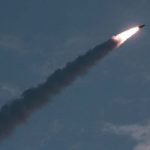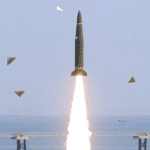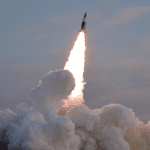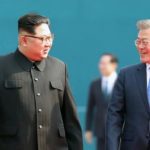North Korea has fired several cruise missiles towards the sea to the west of the Korean Peninsula, South Korea’s military said, marking the second missile launch in apparent protest over the arrival of a nuclear-armed United States submarine at a South Korean port.
South Korea’s Joint Chiefs of Staff (JCS) said on Saturday the launches were detected beginning at about 4am local time (19:00 Friday GMT).
“Our military has bolstered surveillance and vigilance while closely cooperating with the United States and maintaining a firm readiness posture,” the JCS said, according to South Korea’s Yonhap News Agency.
On Wednesday, North Korea fired two short-range ballistic missiles from an area near its capital, Pyongyang. They flew about 550km (341 miles) before landing in waters east of the Korean Peninsula.
The flight distance of those missiles roughly matched the distance between Pyongyang and the South Korean port city of Busan, where the nuclear-armed submarine, the USS Kentucky, made the first visit by a US nuclear-armed submarine to South Korea since the 1980s.
The distance which the missiles fired on Saturday travelled was not immediately released by the JCS.
The missile launches come as Seoul and Washington ramp up defence cooperation in the face of growing tensions with the North, including joint US and South Korean military exercises with advanced stealth jets and new rounds of nuclear contingency planning meetings.
North Korea’s defence minister issued a veiled threat on Thursday, suggesting the docking of the Kentucky in South Korea could be grounds for a nuclear attack by the North.
North Korea’s defence minister Kang Sun-nam said the Ohio-class submarine’s deployment may have fallen “under the conditions of the use of nuclear weapons specified in the DPRK law on the nuclear force policy”, using an acronym for North Korea’s official name.
South Korea’s defence ministry on Friday described the deployment of the Kentucky and the nuclear contingency planning meetings between Washington and Seoul as “defensive response measures” to counter the North Korean threat.
South Korea’s defence ministry also said that any use of nuclear weapons by North Korea would prompt an “immediate and decisive response” resulting in the “end” of Kim Jong Un’s regime.
North Korea has fired several cruise missiles towards the sea to the west of the Korean Peninsula, South Korea’s military said, marking the second missile launch in apparent protest over the arrival of a nuclear-armed United States submarine at a South Korean port.
South Korea’s Joint Chiefs of Staff (JCS) said on Saturday the launches were detected beginning at about 4am local time (19:00 Friday GMT).
“Our military has bolstered surveillance and vigilance while closely cooperating with the United States and maintaining a firm readiness posture,” the JCS said, according to South Korea’s Yonhap News Agency.
On Wednesday, North Korea fired two short-range ballistic missiles from an area near its capital, Pyongyang. They flew about 550km (341 miles) before landing in waters east of the Korean Peninsula.
The flight distance of those missiles roughly matched the distance between Pyongyang and the South Korean port city of Busan, where the nuclear-armed submarine, the USS Kentucky, made the first visit by a US nuclear-armed submarine to South Korea since the 1980s.
The distance which the missiles fired on Saturday travelled was not immediately released by the JCS.
The missile launches come as Seoul and Washington ramp up defence cooperation in the face of growing tensions with the North, including joint US and South Korean military exercises with advanced stealth jets and new rounds of nuclear contingency planning meetings.
North Korea’s defence minister issued a veiled threat on Thursday, suggesting the docking of the Kentucky in South Korea could be grounds for a nuclear attack by the North.
North Korea’s defence minister Kang Sun-nam said the Ohio-class submarine’s deployment may have fallen “under the conditions of the use of nuclear weapons specified in the DPRK law on the nuclear force policy”, using an acronym for North Korea’s official name.
South Korea’s defence ministry on Friday described the deployment of the Kentucky and the nuclear contingency planning meetings between Washington and Seoul as “defensive response measures” to counter the North Korean threat.
South Korea’s defence ministry also said that any use of nuclear weapons by North Korea would prompt an “immediate and decisive response” resulting in the “end” of Kim Jong Un’s regime.
North Korea has fired several cruise missiles towards the sea to the west of the Korean Peninsula, South Korea’s military said, marking the second missile launch in apparent protest over the arrival of a nuclear-armed United States submarine at a South Korean port.
South Korea’s Joint Chiefs of Staff (JCS) said on Saturday the launches were detected beginning at about 4am local time (19:00 Friday GMT).
“Our military has bolstered surveillance and vigilance while closely cooperating with the United States and maintaining a firm readiness posture,” the JCS said, according to South Korea’s Yonhap News Agency.
On Wednesday, North Korea fired two short-range ballistic missiles from an area near its capital, Pyongyang. They flew about 550km (341 miles) before landing in waters east of the Korean Peninsula.
The flight distance of those missiles roughly matched the distance between Pyongyang and the South Korean port city of Busan, where the nuclear-armed submarine, the USS Kentucky, made the first visit by a US nuclear-armed submarine to South Korea since the 1980s.
The distance which the missiles fired on Saturday travelled was not immediately released by the JCS.
The missile launches come as Seoul and Washington ramp up defence cooperation in the face of growing tensions with the North, including joint US and South Korean military exercises with advanced stealth jets and new rounds of nuclear contingency planning meetings.
North Korea’s defence minister issued a veiled threat on Thursday, suggesting the docking of the Kentucky in South Korea could be grounds for a nuclear attack by the North.
North Korea’s defence minister Kang Sun-nam said the Ohio-class submarine’s deployment may have fallen “under the conditions of the use of nuclear weapons specified in the DPRK law on the nuclear force policy”, using an acronym for North Korea’s official name.
South Korea’s defence ministry on Friday described the deployment of the Kentucky and the nuclear contingency planning meetings between Washington and Seoul as “defensive response measures” to counter the North Korean threat.
South Korea’s defence ministry also said that any use of nuclear weapons by North Korea would prompt an “immediate and decisive response” resulting in the “end” of Kim Jong Un’s regime.
North Korea has fired several cruise missiles towards the sea to the west of the Korean Peninsula, South Korea’s military said, marking the second missile launch in apparent protest over the arrival of a nuclear-armed United States submarine at a South Korean port.
South Korea’s Joint Chiefs of Staff (JCS) said on Saturday the launches were detected beginning at about 4am local time (19:00 Friday GMT).
“Our military has bolstered surveillance and vigilance while closely cooperating with the United States and maintaining a firm readiness posture,” the JCS said, according to South Korea’s Yonhap News Agency.
On Wednesday, North Korea fired two short-range ballistic missiles from an area near its capital, Pyongyang. They flew about 550km (341 miles) before landing in waters east of the Korean Peninsula.
The flight distance of those missiles roughly matched the distance between Pyongyang and the South Korean port city of Busan, where the nuclear-armed submarine, the USS Kentucky, made the first visit by a US nuclear-armed submarine to South Korea since the 1980s.
The distance which the missiles fired on Saturday travelled was not immediately released by the JCS.
The missile launches come as Seoul and Washington ramp up defence cooperation in the face of growing tensions with the North, including joint US and South Korean military exercises with advanced stealth jets and new rounds of nuclear contingency planning meetings.
North Korea’s defence minister issued a veiled threat on Thursday, suggesting the docking of the Kentucky in South Korea could be grounds for a nuclear attack by the North.
North Korea’s defence minister Kang Sun-nam said the Ohio-class submarine’s deployment may have fallen “under the conditions of the use of nuclear weapons specified in the DPRK law on the nuclear force policy”, using an acronym for North Korea’s official name.
South Korea’s defence ministry on Friday described the deployment of the Kentucky and the nuclear contingency planning meetings between Washington and Seoul as “defensive response measures” to counter the North Korean threat.
South Korea’s defence ministry also said that any use of nuclear weapons by North Korea would prompt an “immediate and decisive response” resulting in the “end” of Kim Jong Un’s regime.
North Korea has fired several cruise missiles towards the sea to the west of the Korean Peninsula, South Korea’s military said, marking the second missile launch in apparent protest over the arrival of a nuclear-armed United States submarine at a South Korean port.
South Korea’s Joint Chiefs of Staff (JCS) said on Saturday the launches were detected beginning at about 4am local time (19:00 Friday GMT).
“Our military has bolstered surveillance and vigilance while closely cooperating with the United States and maintaining a firm readiness posture,” the JCS said, according to South Korea’s Yonhap News Agency.
On Wednesday, North Korea fired two short-range ballistic missiles from an area near its capital, Pyongyang. They flew about 550km (341 miles) before landing in waters east of the Korean Peninsula.
The flight distance of those missiles roughly matched the distance between Pyongyang and the South Korean port city of Busan, where the nuclear-armed submarine, the USS Kentucky, made the first visit by a US nuclear-armed submarine to South Korea since the 1980s.
The distance which the missiles fired on Saturday travelled was not immediately released by the JCS.
The missile launches come as Seoul and Washington ramp up defence cooperation in the face of growing tensions with the North, including joint US and South Korean military exercises with advanced stealth jets and new rounds of nuclear contingency planning meetings.
North Korea’s defence minister issued a veiled threat on Thursday, suggesting the docking of the Kentucky in South Korea could be grounds for a nuclear attack by the North.
North Korea’s defence minister Kang Sun-nam said the Ohio-class submarine’s deployment may have fallen “under the conditions of the use of nuclear weapons specified in the DPRK law on the nuclear force policy”, using an acronym for North Korea’s official name.
South Korea’s defence ministry on Friday described the deployment of the Kentucky and the nuclear contingency planning meetings between Washington and Seoul as “defensive response measures” to counter the North Korean threat.
South Korea’s defence ministry also said that any use of nuclear weapons by North Korea would prompt an “immediate and decisive response” resulting in the “end” of Kim Jong Un’s regime.
North Korea has fired several cruise missiles towards the sea to the west of the Korean Peninsula, South Korea’s military said, marking the second missile launch in apparent protest over the arrival of a nuclear-armed United States submarine at a South Korean port.
South Korea’s Joint Chiefs of Staff (JCS) said on Saturday the launches were detected beginning at about 4am local time (19:00 Friday GMT).
“Our military has bolstered surveillance and vigilance while closely cooperating with the United States and maintaining a firm readiness posture,” the JCS said, according to South Korea’s Yonhap News Agency.
On Wednesday, North Korea fired two short-range ballistic missiles from an area near its capital, Pyongyang. They flew about 550km (341 miles) before landing in waters east of the Korean Peninsula.
The flight distance of those missiles roughly matched the distance between Pyongyang and the South Korean port city of Busan, where the nuclear-armed submarine, the USS Kentucky, made the first visit by a US nuclear-armed submarine to South Korea since the 1980s.
The distance which the missiles fired on Saturday travelled was not immediately released by the JCS.
The missile launches come as Seoul and Washington ramp up defence cooperation in the face of growing tensions with the North, including joint US and South Korean military exercises with advanced stealth jets and new rounds of nuclear contingency planning meetings.
North Korea’s defence minister issued a veiled threat on Thursday, suggesting the docking of the Kentucky in South Korea could be grounds for a nuclear attack by the North.
North Korea’s defence minister Kang Sun-nam said the Ohio-class submarine’s deployment may have fallen “under the conditions of the use of nuclear weapons specified in the DPRK law on the nuclear force policy”, using an acronym for North Korea’s official name.
South Korea’s defence ministry on Friday described the deployment of the Kentucky and the nuclear contingency planning meetings between Washington and Seoul as “defensive response measures” to counter the North Korean threat.
South Korea’s defence ministry also said that any use of nuclear weapons by North Korea would prompt an “immediate and decisive response” resulting in the “end” of Kim Jong Un’s regime.
North Korea has fired several cruise missiles towards the sea to the west of the Korean Peninsula, South Korea’s military said, marking the second missile launch in apparent protest over the arrival of a nuclear-armed United States submarine at a South Korean port.
South Korea’s Joint Chiefs of Staff (JCS) said on Saturday the launches were detected beginning at about 4am local time (19:00 Friday GMT).
“Our military has bolstered surveillance and vigilance while closely cooperating with the United States and maintaining a firm readiness posture,” the JCS said, according to South Korea’s Yonhap News Agency.
On Wednesday, North Korea fired two short-range ballistic missiles from an area near its capital, Pyongyang. They flew about 550km (341 miles) before landing in waters east of the Korean Peninsula.
The flight distance of those missiles roughly matched the distance between Pyongyang and the South Korean port city of Busan, where the nuclear-armed submarine, the USS Kentucky, made the first visit by a US nuclear-armed submarine to South Korea since the 1980s.
The distance which the missiles fired on Saturday travelled was not immediately released by the JCS.
The missile launches come as Seoul and Washington ramp up defence cooperation in the face of growing tensions with the North, including joint US and South Korean military exercises with advanced stealth jets and new rounds of nuclear contingency planning meetings.
North Korea’s defence minister issued a veiled threat on Thursday, suggesting the docking of the Kentucky in South Korea could be grounds for a nuclear attack by the North.
North Korea’s defence minister Kang Sun-nam said the Ohio-class submarine’s deployment may have fallen “under the conditions of the use of nuclear weapons specified in the DPRK law on the nuclear force policy”, using an acronym for North Korea’s official name.
South Korea’s defence ministry on Friday described the deployment of the Kentucky and the nuclear contingency planning meetings between Washington and Seoul as “defensive response measures” to counter the North Korean threat.
South Korea’s defence ministry also said that any use of nuclear weapons by North Korea would prompt an “immediate and decisive response” resulting in the “end” of Kim Jong Un’s regime.
North Korea has fired several cruise missiles towards the sea to the west of the Korean Peninsula, South Korea’s military said, marking the second missile launch in apparent protest over the arrival of a nuclear-armed United States submarine at a South Korean port.
South Korea’s Joint Chiefs of Staff (JCS) said on Saturday the launches were detected beginning at about 4am local time (19:00 Friday GMT).
“Our military has bolstered surveillance and vigilance while closely cooperating with the United States and maintaining a firm readiness posture,” the JCS said, according to South Korea’s Yonhap News Agency.
On Wednesday, North Korea fired two short-range ballistic missiles from an area near its capital, Pyongyang. They flew about 550km (341 miles) before landing in waters east of the Korean Peninsula.
The flight distance of those missiles roughly matched the distance between Pyongyang and the South Korean port city of Busan, where the nuclear-armed submarine, the USS Kentucky, made the first visit by a US nuclear-armed submarine to South Korea since the 1980s.
The distance which the missiles fired on Saturday travelled was not immediately released by the JCS.
The missile launches come as Seoul and Washington ramp up defence cooperation in the face of growing tensions with the North, including joint US and South Korean military exercises with advanced stealth jets and new rounds of nuclear contingency planning meetings.
North Korea’s defence minister issued a veiled threat on Thursday, suggesting the docking of the Kentucky in South Korea could be grounds for a nuclear attack by the North.
North Korea’s defence minister Kang Sun-nam said the Ohio-class submarine’s deployment may have fallen “under the conditions of the use of nuclear weapons specified in the DPRK law on the nuclear force policy”, using an acronym for North Korea’s official name.
South Korea’s defence ministry on Friday described the deployment of the Kentucky and the nuclear contingency planning meetings between Washington and Seoul as “defensive response measures” to counter the North Korean threat.
South Korea’s defence ministry also said that any use of nuclear weapons by North Korea would prompt an “immediate and decisive response” resulting in the “end” of Kim Jong Un’s regime.



